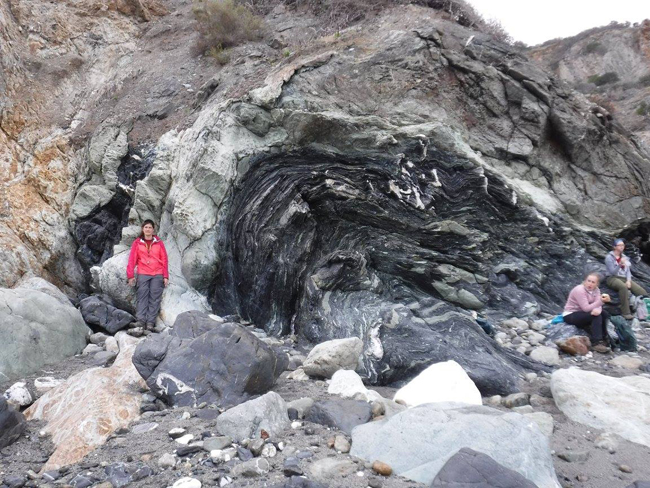Happy Friday! Here’s another fold from Catalina Island, California – an antiform in metasediments, courtesy of Sarah Penniston-Dorland of the University of Maryland:

Happy Friday! Here’s another fold from Catalina Island, California – an antiform in metasediments, courtesy of Sarah Penniston-Dorland of the University of Maryland:

The rocks in the core resemble mixed rock types we see in other Jurassic-Cretaceous units in S. Alaska and the San Juan Islands in Washington. I infer the green bodies are basalt or basaltic tuffs. How were they mixed with the sandstone and mudstone?
I’ll leave that to Sarah to answer.
Wow. Fascinating photo. This is what I see, right or wrong:
1. To the left, the orange and white rocks almost appear to be a potassium feldspar rich melt. It could also be limonite stained quartzite with calcium carbonate cementing. Or someone spilled a vat of orange sherbet and vanilla ice cream, but that’s a low probability event. It would explain what the two on the right are eating though.
2. The light gray rock looks like a volcanic tuff.
3. The black & white rock looks like a mafic, folded intrusion, possibly a diabase. Or a bit of seafloor maybe?
4. The medium gray and white rock looks like a migmatite or a gneiss but is clearly grading out of the darker rock.
The whole scene looks igneous in origin, possibly a piece of a volcanic arc related to the Farallon subduction zone. It might even be a bit of an accretionary wedge. Lots of possibilities here.
It is indeed accretionary wedge material, but you may have missed the “metasediments” in the description.
No, I saw that. That just means metamorphosed sediments to me. That’s not too specific.
So, do I pass my freshman geology midterm?